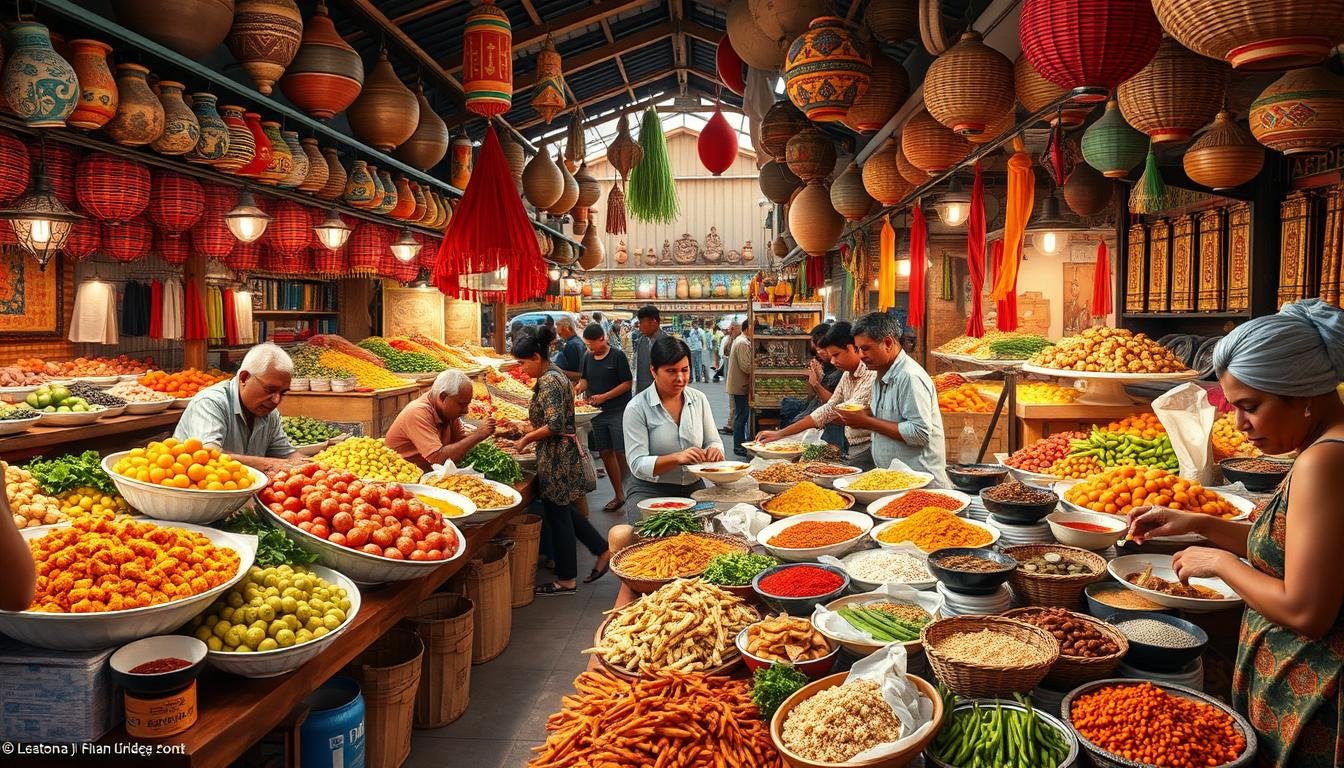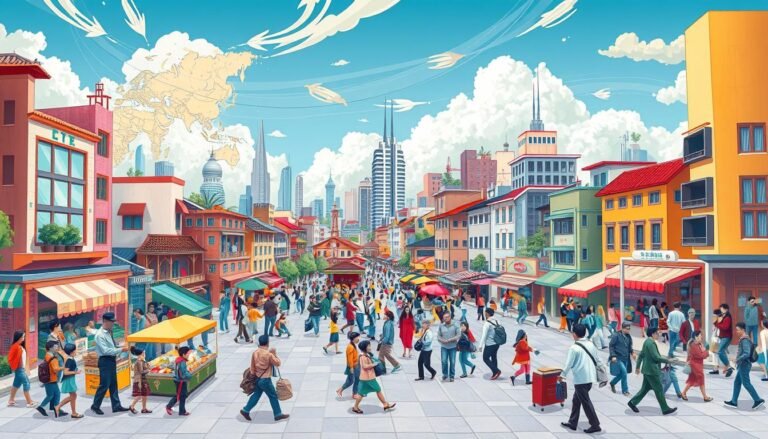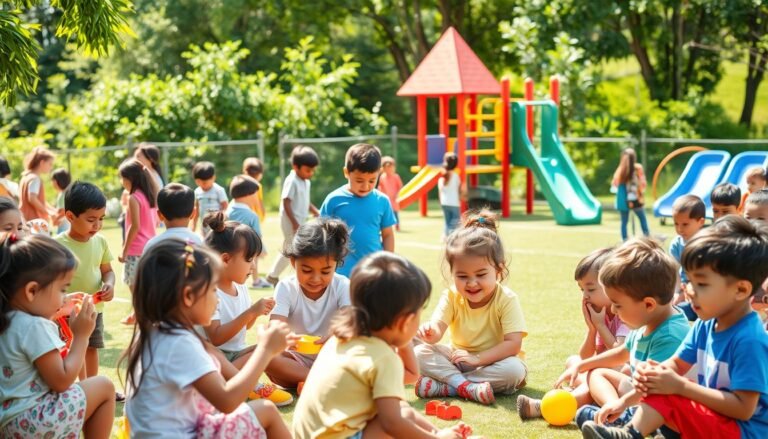The Sociology of Food: Culture, Identity, and Power
Ever thought about how a simple meal can shape our society? The sociology of food looks into this question. It shows how social, cultural, and economic factors affect what and how we eat. From Chinese takeaways to Italian pasta, our food choices deeply impact our identities.
Cultural anthropology and social theory blend in this field, giving us deep insights. For example, an Italian child can name twenty-two types of pasta. This shows the strong cultural values tied to food in Italy. In contrast, when talking about fried eggs, the French think about the experience, while Americans worry about cholesterol.
Food globalization has changed cities like Vancouver, offering new culinary experiences and changing cultural identities. Chinese takeaways have created jobs and helped with cultural exchange. But, this change also brings up questions about what’s real and what’s not.
Universities like UBC are leading the way in teaching about food and culture. They use food to bring people together, sharing meals and stories. This helps build strong connections and bridges between cultures.
Key Takeaways
- Food sociology looks at how what we eat affects us and our society.
- Different cultures see food differently, showing their values.
- Food globalization brings cultures together but makes us wonder about what’s real.
- Universities are key in teaching about food and culture.
- Sharing meals and traditions helps build community and inclusivity.
Understanding the Sociology of Food
Food sociology looks at how food connects with society. It shows how what we eat mirrors our culture, social norms, and power. This field is part of social sciences.
Defining Food Sociology
It studies the social, cultural, and economic sides of food. Food sociology is a growing area, with more research since the 1990s. It looks at how society affects our eating habits and what we choose to eat.
Importance in Social Sciences
Studying food through sociology helps us understand human behavior. It shows our food choices aren’t random. They’re shaped by culture, religion, economy, and politics. For example, in many places, red meat is seen as a manly food, while fruits and veggies are for women.
Intersection with Cultural Anthropology
Food sociology meets cultural anthropology. It shows how food traditions tell us about our cultures. For example, Thai, Italian, Indian, and Mexican foods link to their cultures. It also looks at how we learn what foods are right or wrong through culture.
- Food habits are social constructions, not universal or natural
- Early experiences play a crucial role in shaping food preferences
- Different cultures exhibit significant variations in food habits
By mixing sociology, anthropology, history, and other fields, we get a full picture of our food world. This helps us understand our complex relationship with food.
Food as a Cultural Symbol
Food is key in shaping our cultural identity and keeping culinary traditions alive. It means more than just eating. It’s a way to share values, beliefs, and connect with others.
Studies show that food brings families closer together. A study with 12 college students in the Midwest found that eating together strengthens family bonds. These meals are chances to connect, plan activities, and promote healthy habits.
- Communication: Food lets people express themselves in different cultures
- Relational development: Sharing meals builds and strengthens relationships
- Power dynamics: What we eat shows our social status and position
- Heritage preservation: Traditional dishes link us to our heritage
Gender matters in the kitchen too. In 2008, 81.5% of head-cooks and chefs were men. By 2023, women made up 23.3% of these roles.
| Year | Male Head-cooks/Chefs | Female Head-cooks/Chefs |
|---|---|---|
| 2008 | 81.5% | 18.5% |
| 2023 | 76.7% | 23.3% |
Learning about food’s symbolic meaning in cultures helps us value culinary traditions. It shows how food shapes our identity and connects us with others. This understanding gives us insight into the rich world of human experiences and social ties through food.
The Role of Food in Identity Formation
Food shapes who we are, both as individuals and communities. Our food choices show our values and beliefs, making a big part of our identity. This link between food and self goes beyond just eating, touching our deep cultural and personal lives.
Personal and Collective Identities
Our taste buds are tied to our memories and feelings. Certain foods can take us back in time, bringing back memories of past events and people. This is known as the Proustian effect and plays a big role in shaping who we are.
Food Choices and Self-Expression
What we eat tells a lot about us. Studies show different diets like fast food, health food, and gourmet food link to certain personalities. For example, health food lovers are often seen as caring for the environment. Gourmet food fans are viewed as sophisticated and open-minded.
Culinary Traditions and Heritage
Food connects us to our cultural past. Traditional dishes mark our ethnic or national identity, keeping us tied to our roots. For example, the Sunday dinner in Italian families shows how food rituals keep families and cultures close.
| Diet Type | Perceived Personality |
|---|---|
| Fast Food | Religious Conservative |
| Health Food | Environmentally Conscious |
| Vegetarian | Pacifist |
| Gourmet Food | Liberal and Sophisticated |
Looking at how food shapes our identity gives us deep insights into culture and society. It shows how our food choices and traditions craft our personal stories and group identities. Food is key to human culture and society.
Power Dynamics in Food Systems
Food systems show us the complex power structures in our society. Who gets good food often depends on their money and social status. This leads to health differences among people. Big food companies also play a big part in making these health gaps worse by controlling how food is made and sold.
Feasts and communal meals show us how power works in our society. The person hosting the meal has a lot of power by choosing who comes and what to eat. Where people sit and their roles at the table show who is more important.
But, communal dining can also change the game. When everyone comes together for a meal, it can make everyone feel more equal. This shows how sharing meals can change social power structures.
“Understanding power dynamics in feasting practices is crucial for uncovering cultural negotiations, power distribution, and community identities.”
Because big companies control the food industry, groups are fighting back. They want to make sure local communities have control over their food. This is a way to challenge the big companies and fix the power imbalance in the food world.
| Aspect | Impact on Power Dynamics |
|---|---|
| Host’s Role | Determines guest list and menu |
| Seating Arrangement | Reflects social status and hierarchy |
| Inclusive Feasts | Challenge existing power structures |
| Food Sovereignty Movements | Promote local control and address inequalities |
Looking into power in food systems helps us see what our society values and who we are as a group. It shows how food connects to culture and social differences. This knowledge can lead to fairer and better food systems for everyone.
Globalization and Its Impact on Food Culture
Globalization has changed how we eat, mixing flavors from all over the world. This change has brought new tastes and dining experiences. But, it also makes us wonder about keeping traditional food cultures alive.
Cultural Exchange Through Cuisine
Food is now a key way for cultures to meet in our connected world. When people move, they take their recipes with them, sharing new flavors. This mixing of foods has made local food scenes richer and our taste buds more adventurous.
Adaptation of Traditional Dishes
When foods travel, they often change to fit local tastes and ingredients. For instance, in Japan, people eat half as much rice as they used to, from 320 grams to 160 grams a day. Yet, Japanese rice is still very important, showing how traditional foods can change but keep their cultural value.
The Rise of Fusion Cuisine
Fusion cuisine shows the best of global food mixing. Chefs mix cooking styles and flavors from around the world to make new dishes. This trend shows how connected our world is and celebrates the variety of global foods.
| Traditional Dish | Fusion Adaptation | Cultural Influence |
|---|---|---|
| Sushi | California Roll | Japanese-American |
| Pizza | Tandoori Chicken Pizza | Italian-Indian |
| Tacos | Korean BBQ Tacos | Mexican-Korean |
While globalization brings new food delights, it’s important to also protect traditional food cultures. Supporting local food and teaching about cultures can help keep our food world diverse in this global age.
Food and Social Stratification
Social class greatly affects what we eat and how we get food. Dr. Kate Gardner Burt, an Associate Professor at Lehman College, has studied this. She found that racial and ethnic differences in food systems are big problems. These issues affect our food choices at home and in our communities.
Not everyone has the same access to food. In 2020, 345 million people worldwide faced serious food insecurity. This is a big problem in the Global South, with some European countries seeing over 20% of their people struggling to get enough food.
Our economic status changes what we eat. When money is tight, people often choose foods that are cheap but not good for them. This can lead to not getting enough nutrients and a higher chance of getting diseases.
“Understanding food culture requires an analysis of personal, community, and societal values, assumptions, norms, and biases.” – Dr. Kate Gardner Burt
Food deserts show how unequal access to food can be. These are areas in low-income neighborhoods without grocery stores. People there often have to buy food from places that don’t have healthy choices.
| Income Level | Food Access | Dietary Patterns |
|---|---|---|
| Low | Limited, often in food deserts | High in processed foods, sugar, and fats |
| Middle | Moderate, some limitations | Mixed, with some healthy options |
| High | Abundant, diverse options | Often healthier, more varied |
We need to tackle these issues from many angles. We must look at how social class, food access, and what we eat are connected. By understanding this, we can work towards better food systems and health for everyone, no matter their social class.
The Sociology of Food: Culture, Identity, and Power
The study of food sociology looks at how what we eat shows and shapes our social world. It uses sociological theories to see how food affects culture, who we are, and who has power.
Theoretical Frameworks
Food studies use many theories. Symbolic interactionism shows how what we eat says something in social situations. Conflict theory looks at how power affects food systems. These ideas help us grasp how food ties to society.
Key Concepts and Principles
Important ideas in food sociology include culinary capital and gastronationalism. Culinary capital is about knowing how to cook and eat. Gastronationalism looks at how food shows our national identity.
Contemporary Research Trends
Today, food studies focus on big issues like food justice and being sustainable. Researchers study how technology changes how we produce and eat food. They also look at gender roles in cooking.
| Year | Male Head Chefs (%) | Female Head Chefs (%) |
|---|---|---|
| 2008 | 81.5 | 18.5 |
| 2023 | 76.7 | 23.3 |
This data shows that more women are becoming head chefs, which reflects changes in society and the kitchen.
Food Rituals and Social Bonding
Food rituals are key to social interactions, building connections and community bonds. These shared moments, known as commensality, create strong ties among people and groups. From family dinners to cultural festivals, sharing meals is vital for our social life.
Cultural traditions often center on food, strengthening group identity and keeping heritage alive. In the U.S., with 14.1% first-generation Americans and 12.3% second-generation, food rituals link different cultures. These shared moments help diverse groups find common ground through food.
Food rituals do more than keep culture alive. They give people a sense of belonging and connection, especially for minority groups facing challenges in finding traditional foods. This is true for college students, 16% of whom are second-generation Americans, trying to keep their cultural food traditions while away from home.
“Food is our common ground, a universal experience.” – James Beard
Understanding the role of food rituals in social bonding helps us build more inclusive communities. This approach honors diversity and strengthens our social ties, creating unity through shared food experiences.
The Politics of Food Production and Distribution
The world of food politics is complex, filled with power struggles and different interests. Every step from farm to fork is shaped by forces that affect what we eat and how it gets to us.
Food sovereignty and security
Food sovereignty movements are growing worldwide. They aim for local control over food systems, fighting against big corporations. Yet, food security is still a big issue, linked to global inequality and the environment.
Corporate influence on food systems
Big food companies have a lot of power in making food policies and what we choose to eat. They affect everything from farm subsidies to how food is marketed. This focus on profit over health and the environment has led to talks about being open and responsible in our food systems.
Sustainable food movements
To tackle these problems, sustainable food movements have started. They push for food that’s good for the planet and fair for everyone, unlike industrial farming. From farm-to-table restaurants to community-supported farms, these efforts are changing how we see food, one meal at a time.
Source Links
- The Sociology of Food: Exploring Identity, Culture, and Society through Chinese Takeaways
- The intersection of culture and cuisine: How food shapes our identity – Faculty of Arts
- The Anthropology of Food: Taste, Ritual, Identity, and Power — Scholar Launch
- cfp | call for papers
- The Social and Cultural Uses of Food (VI.14) – The Cambridge World History of Food
- Microsoft Word – Teoh.Ashley.CST(1).docx
- The Power of Food Memories in Identity Formation
- Power dynamics – Vocab, Definition, and Must Know Facts | Fiveable
- New Books in Food Studies – ASFS
- Globalization and its Impact on Cultural Identity: An Analysis
- 14.3 Food and Cultural Identity – Introduction to Anthropology | OpenStax
- Perspective: Food and Identity
- A scoping review of the social dimensions in food insecurity and poverty assessments
- Exploring the Sociology of Food: Understanding Social Inequality, Cultural Practices, and Globalization
- How to study ethnic food: senses, power, and intercultural studies – Journal of Ethnic Foods
- Sociology of food
- The impact that cultural food security has on identity and well-being in the second-generation U.S. American minority college students
- No title found
- Knowing food and growing food: Beyond the production–consumption debate in the sociology of agriculture







